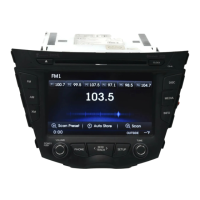
Do you have a question about the Hyundai veloster turbo 2013 and is the answer not in the manual?
| Brand | Hyundai |
|---|---|
| Model | veloster turbo 2013 |
| Category | Automobile |
| Language | English |
Guidance on effectively using the owner's manual, including understanding its layout and sections.
Information on the correct type of fuel, ethanol/methanol content, and related warnings for your vehicle.
Recommended procedures for the first 600 miles to ensure optimal vehicle performance and longevity.
Descriptions of various warning and indicator lights found on the vehicle's instrument panel.
Identification and location of interior controls, switches, and features.
Identification of components and controls located on the vehicle's instrument panel.
Locations of key components and fluids within the engine bay for maintenance checks.
Details on seat adjustments, headrests, seatback recliners, and folding rear seats.
Comprehensive information on seat belt usage, restraint systems, and important safety warnings.
Guidelines for installing and using child safety seats, including warnings and proper placement.
Explanation of the SRS airbag system, its components, operation, and safety precautions.
Information on key operations, smart key features, and ignition switch usage.
Details on smart key functions, locking/unlocking, and engine start/stop operations.
Explanation of the electronic engine immobilizer system and its function.
Precautions and potential issues related to the vehicle's transmitter operation.
Instructions on operating the vehicle's door locks from inside and outside.
Instructions for opening, closing, and securing the vehicle's tailgate.
Operation and features of the vehicle's power windows, including auto functions.
Step-by-step instructions for opening and closing the vehicle's hood.
How to open and close the fuel filler lid and related refueling precautions.
Operation, precautions, and resetting procedures for the vehicle's sunroof.
Information on the electric power steering system and tilt/telescope steering adjustments.
Instructions for adjusting rearview and side mirrors, including day/night and Blue Link features.
Overview of the instrument cluster, including gauges and indicators.
Details about the vehicle's audio system, including radio reception and controls.
Essential pre-drive checks, safety warnings, and familiarization with controls.
Explanation of ignition switch positions (LOCK, ACC, START) and their functions.
Instructions on starting and stopping the engine using the push-button system.
Operation and precautions for the manual transmission, including shifting gears.
Operation and features of the automatic and dual-clutch transmission systems.
Advice for driving safely in hazardous conditions like snow, ice, or mud.
Tips for safe and efficient driving on highways, focusing on tires and vehicle checks.
Recommendations for driving safely in winter conditions, including snow tires and chains.
Understanding vehicle load limits, seating capacity, and cargo weight calculations.
Vehicle weight specifications and luggage volume details.
Instructions on how and when to use the hazard warning flashers.
Step-by-step instructions for changing a flat tire using the provided jack and tools.
Instructions for using the temporary tire repair kit to seal and inflate a punctured tire.
Guidelines and precautions for safely towing the vehicle, including hook installation.
Identification of key components and fluid reservoirs in the engine bay for maintenance.
General advice on vehicle maintenance, emphasizing professional service.
Owner's responsibilities for performing basic maintenance checks and record-keeping.
Recommended service intervals for routine maintenance based on mileage and time.
Procedures for checking and changing the engine oil and filter, including oil type recommendations.
Inspection of drive belts for wear, cracks, and tension; replacement if necessary.
Information on fuel filter inspection, replacement, and potential issues.
Instructions for inspecting and replacing the air cleaner filter.
Checking brake and clutch fluid levels and proper fluid type specifications.
Checking the windshield washer fluid level and recommended fluid types.
How to check the parking brake stroke and proper application.
Inspection and replacement procedures for front and rear windshield wiper blades.
Tips for battery service, safety precautions, and recharging procedures.
Information on the TPMS, malfunction indicator, and low tire pressure warnings.
Instructions for changing a flat tire while accounting for the TPMS.
Details on tire care, recommended sizes, inflation pressures, and wheel alignment.
Information about the vehicle's fuse system, including location and replacement.
Specifications for engine displacement, bore/stroke, firing order, and cylinder count.
Table listing bulb types and wattages for various vehicle lights.
Details on tire sizes, recommended inflation pressures, torque specs, and cautions.
Vehicle weight specifications including gross weight and luggage volume.











